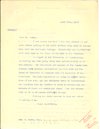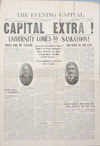“…to satisfy the wishes of ambitious towns” - Finding a Site

DP McColl to George H Locke, 15 April 1908: “The main tug-of-war now seems to be the selection of the site, and the different towns in Saskatchewan are tumbling over one another in order to advance the interests of their own particular place. What the outcome will be it is of course difficult to say.”
Walter Murray expressed concern about the location of the University even in his letter of application to be its president. “Is there any likelihood of its being dismembered and the fragments scattered over the province to satisfy the wishes of ambitious towns?” he wondered. The site of the future University was of considerable importance in Murray’s view: he understood the University to be a servant of the people of the province, solving problems in “agriculture, industries, commerce, government, and social life. To be of the greatest service, the University must be placed where it is easy of access and in close touch with the life of the province.” He favoured building in Regina, the provincial capital.
Murray would later stress that the institution was “the people’s University,” but it would have considerable local commercial impact. In 1908 the council had determined the University’s scope: colleges of Arts and Science including art, music and commerce, Agriculture with forestry, Domestic Science, Education, Engineering, Law, Medicine, Pharmacy, Veterinary Science and Dentistry. This envisioned a significant research institution by any standard, one which would certainly provide its host city with “prestige, population and business.” Battleford, Moose Jaw, Prince Albert, Regina and Saskatoon all lobbied to host the institution.
Although the final decision resided with the Board of Governors, provincial politics played a role. The provincial government was committed to a policy of decentralization; and following an election that returned Conservative MLAs from Moose Jaw and Prince Albert, (Liberal) Premier Walter Scott indicated both towns had put themselves out of the competition. It had become a choice between Regina and Saskatoon. In a letter to Premier Scott, Murray was clear about any political interference in the decision:
You have in a manner that is beyond praise placed the University and indeed all education above party issues. … If you interfere in this matter what is there to prevent interference in the future with the appointment or dismissal of a professor, the letting of a contract, or the dozen and one things men wish to use to their own advantage. ….If we settle University affairs in this manner what can we expect of the young men and women who come to that institution for instruction in the highest things of life. I would rather see a minister rob the charity boxes than see a University pollute the springs of Education. … To me Education is a religion and the University as sacred as the Church. … You have been prepared to make great sacrifices for what you believed was best. Your spirit is contagious.” (Saskatoon: The First Half-Century, p. 80-81)
The vote on 7 April 1909 was never formally recorded, but by a margin of either 6-3 or 5-4, Saskatoon was chosen. The news came by telegraph at 11:30 pm: “whistles were sounded and at first alarmed the whole town. People got up out of bed to know the reason and finding out crowded the streets.”4 Celebrations lasted throughout the next day and night. “The atmosphere of Saskatoon will be changed,” noted lawyer R.W. Shannon. “We shall rise to a higher plane of being.” Saskatoon welcomes the Board of Governors]


